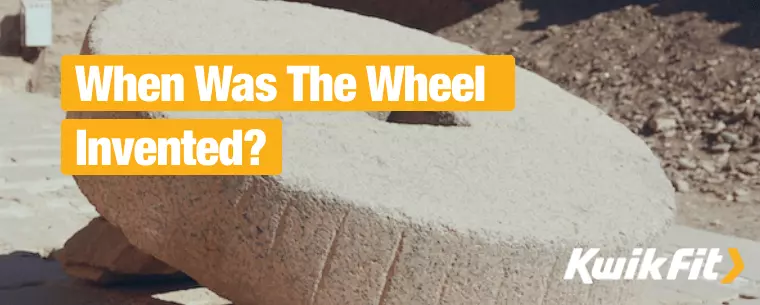When Was The Wheel Invented?
Jack Dreyer | Tuesday 25th July 2023 10:00am

As one of the UK’s leading tyre and car parts experts, the number of times we’ve been asked this question is, quite frankly, unfathomable. So, in a light-hearted departure from our usual motoring advice content, we thought we’d answer the age-old question once and for all: When was the wheel invented?
Giving you a potted history of how the wheel as we know it today came to be, we’ll touch on the great automotive innovations of the past few centuries, spanning from early cart wheels to Continental’s modern day tyre technology.
So, strap in and prepare for a history lesson.
Life before the wheel…
One of the most important things to note about the wheel? Wheels don’t exist in nature. Unlike other inventions that take their design from naturally occurring phenomena — the pitchfork or the aeroplane, for example — wheels have no real natural precursors, which is why it took humans so long to ‘invent’ them.
Before the wheel existed, humans would use sled prototypes to move heavy objects around. Typically, sled movement would be made easier by the accompaniment of some kind of lubricant (there has been evidence of water or pig lard, for example) to reduce the friction between the load and the ground — similar to how tyre tread increases the friction for grip today.
The wheel is born
The earliest evidence for the existence of the wheel actually comes years before it was applied to a vehicular context. In around 4200 - 4000 BC, the iconic wheel shape is thought to have been first used for pottery by the Mesopotamian people.
But, it wasn’t until around 3500 - 3350 BC that humans actually had the genius idea to apply the wheel to moving loads. This means that the stones in Stonehenge were likely dragged there by sled (we don’t envy whoever had to do that!).
The earliest wheeled vehicles
While no records exist that tell us exactly who invented ‘the wheel’ as we know it, or where, for that matter, the earliest wheeled vehicles came about between 3500 and 3350 BC in response to the domestication of horses and the widespread development of road infrastructure and pathways.
Quickly being adopted across Europe and Asia, the wheel at this point was a heavy circular stone. While it’s anachronistic to call them ‘cars’, the earliest wheeled vehicles did bear some resemblance to our motorcars in that they were usually four-wheeled for balance and stability.
One of the earliest pieces of evidence for the ‘car’ is a drawing on the ‘Bronocice pot’, found in a Neolithic settlement in Poland, dating from 3,635 - 3,370 BC, that depicts a four-wheeled vehicle.

Axles
Based on what archaeologists have found, and what historians have evidenced, there were two main types of wheel and axle models in early Neolithic Europe.
Firstly, the more common wagon-style construction which sees the wheel and axle rotate together. And, secondly, the model from the Baden culture in Hungary where the axle does not rotate — both of which date from roughly 3200 - 3000 BC. These allowed for much easier corner manoeuvring.
One of the best preserved examples of early wheel and axle models was found in 2002 in Slovenia. From the remains of this vehicle, believed to have been rolling around about 5,000 years ago, we now know that early wheels were made out of ash and oak — and were also much larger than the wheels we know today, with a diameter of over a metre.
The spoked wheel
For hundreds of years, stone and solid wooden wheels reigned supreme. It wasn’t until approximately 2000 BC that the spoked wheel was invented in Anatolia (or what we now call Turkey) by the Sintasha people. Eventually, this design gained traction (pun intended) across the Mediterranean regions and into classical Greece. Paintings from this period confirm this.
Modern historians believe the reason for this invention to be strongly connected to warfare are the spoke design made the wheels so much lighter, giving those who rode with spokes a significant competitive advantage: allowing them to flee quicker.
If you’re thinking of spokes like the ones that are found on bicycles, however, think again. Wire spoked wheels weren’t invented until the late 1870s. Until the invention of the bicycle, it was wooden spokes or nothing, like the ones you see on roman chariots or mediaeval carts.

‘Reinventing’ the wheel
Shortly after spokes were introduced, things were set in motion for the wheel to quickly become a more complex invention, gaining details and more developed parts.
In Britain, for example, wheels started turning for the Celts when they realised that their chariots would not only be more sturdy but more durable if they reinforced their wheels with iron rims. This can be considered the modern precursors to the humble tyre.
When were tyres invented?
Technically, these Celtic chariots (800-450 BC) claim the title of having the first tyres. From here, spoked wheels continued to evolve and develop, strengthening rims until the mid-nineteenth century. It wasn't until 1847 when Scottish inventor Robert William Thomson issued the first patent for the pneumatic tyre, picking up where the Celts left off.
After this, in 1888, the inflatable tyre became more widely available to the public when they started being mass produced by another Scotsman, John Boyd Dunlop, who allegedly designed an air-filled tyre to prevent his son from getting headaches while riding his tricycle. Name sound familiar?
Wheel & tyre care at Kwik Fit
From dirt roads to Dunlop, we’ve covered a lot of history, all leading up to the tyres we know and love today.
Don’t let centuries of innovation go to waste by leaving your wheels and tyres in a state of disrepair. Keep up to date with regular tyre maintenance and book your vehicle in for any one of our wheel services, from Wheel Alignment checks to wheel balancing, at a Kwik Fit centre near you.
Any facts, figures and prices shown in our blog articles are correct at time of publication.
Featured Articles
Is Your Car Battery Ready for Winter?
Monday 11th November 2024
Is the UK on the verge of ‘the coldest winter for 50 years?’ Even if El Nińo doesn't hit the UK this winter, reduce the risk of a winter breakdown by making sure your car battery is winter-ready.
Your Ultimate Winter Driving Checklist
Monday 31st October 2022
Driving in the colder months presents many challenges. Breakdowns are far more common in winter, so make sure you’re prepared with these essentials.
How to Get Your Car Ready for Winter
Wednesday 28th September 2022
Winter can be a harsh season for your car but planning ahead by carrying out some basic maintenance and packing some essential kit should help you avoid a winter breakdown.







